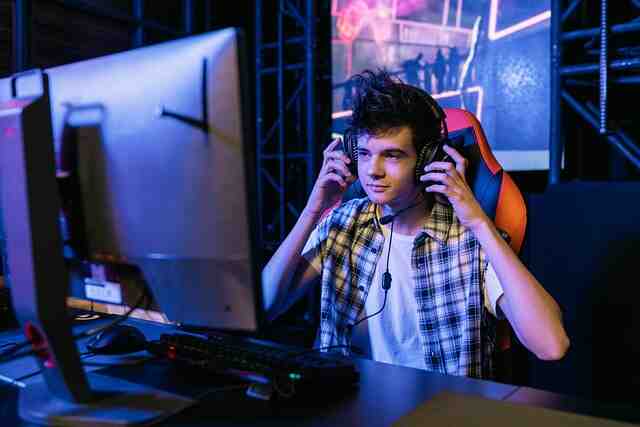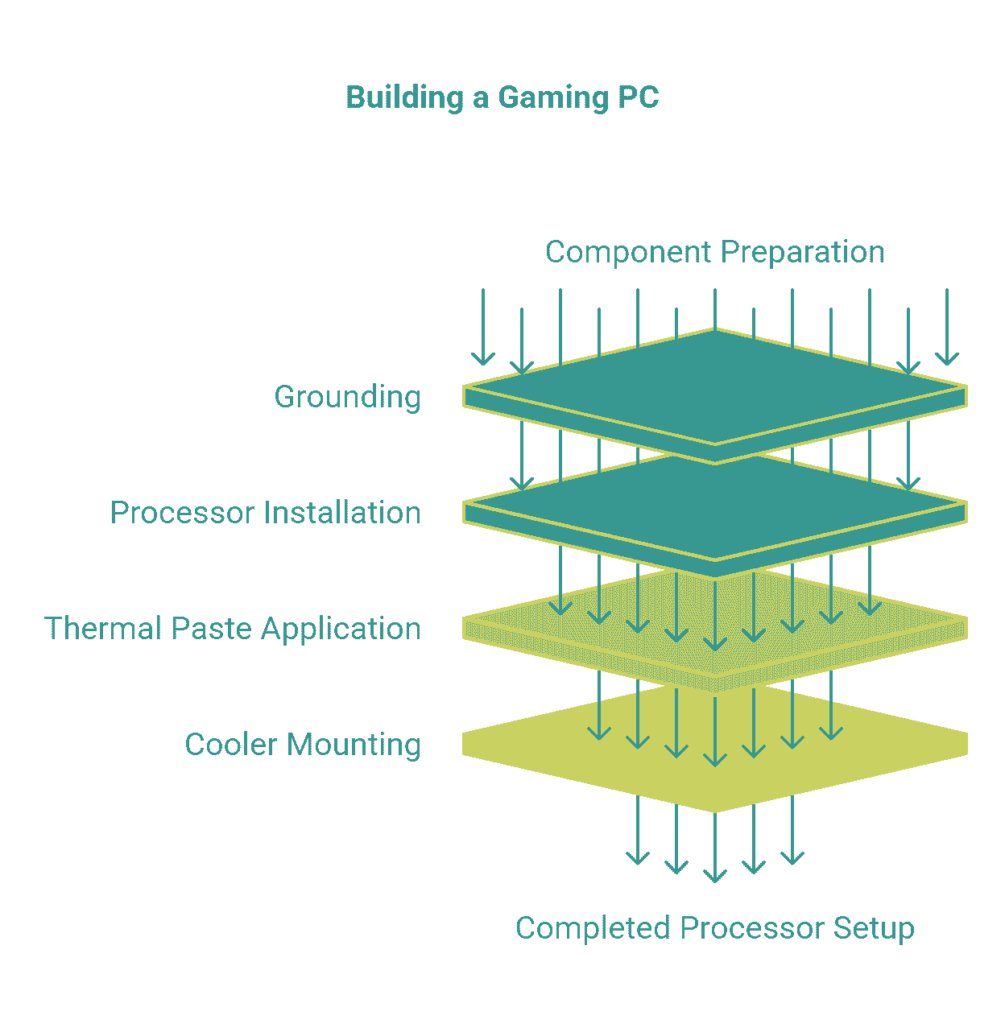Are you tired of tired of lag and unwanted settings? Just Imagine playing your favourite game on your best budget gaming pc built by you! The feeling of Building Your Budget gaming PC in 2025 is just amazing, Trust me when you do it yourself, the unique blend of performance, personalization, and profound satisfaction. As we all know the market is offering numerous pre-built gaming PC machines, entering into the do it yourself (DIY) side in 2025 is an excellent option for players who is looking to save some amount of money and personalising their experience.

Crafting your own Budget gaming PC is really an awesome experience. To do the same you just have to invest some amount of time searching the correct type of product you need for your system, rather than just going and buying the pre-assembled pc from the market.
That way, you can spend your hard-earned money more efficiently and possibly Even get some higher-end quality components without spending a lot. You just have to keep an eye on component prices and capitalize on sales event such as black Friday or festival sales that time usually you get the same product for 20-30% less amount.
Secondly, DIY provides unlimited customization and control over each and every aspect of the machine. By doing it yourself You have the freedom to choose components that precisely meet your gaming needs, performance goals, and even comfort preferences, leading to a truly personalized gaming Hub. This precise control will allow you to upgrade your pc in future, that means you will be able to replace individual parts as needed rather than going for an entirely new system.
Thirdly, the process of building your budget pc is entirely an educational process, this will provide you invaluable insights and deeper understanding of these complex machineries. The knowledge which you will gain through these DIY process of Building Your Budget PC in 2025 will help you in future upgrades as well as in troubleshooting in future and moreover you will navigate through the world of PC technology.
Trust me its huge! Finally, there will be a deep satisfaction and ownership deep inside your heart while playing your favourite game on the device which you personally brought to life. you will be knowing each and every component and how they will work. Trust me it’s a great experience as well as satisfaction!
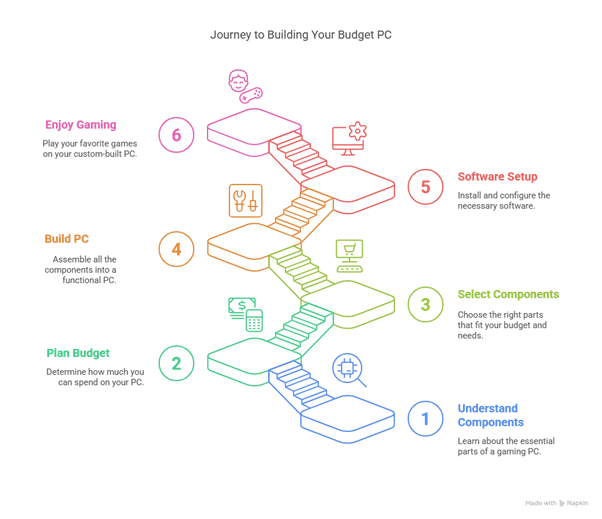
This Article “Building Your Budget gaming PC in 2025” aims to provide a possible, step-by-step roadmap for complete beginners to build a budget gaming PC in 2025 without going bankrupt. I will be with you on this journey of building your gaming machine. Starting with understanding of core components that adds up to your gaming machine.
We will than get into the crucial aspects of planning your budget and selecting precisely the one for your needs, ensuring compatibility and optimal performance. The heart of the guide will be a detailed walkthrough of the physical building process, followed by the instructions for your initial software setup that will bring your creation to life.
II. Lets go through the core components towards Building Your Budget gaming PC in 2025
A. The Brains: Central Processing Unit (PROCESSOR)
The PROCESSOR, Central Processing Unit is often referred to as the “brain” of the computer. It is the main component responsible for all action towards the result given by the computer whether it is a calculation, gaming, saving or executing each and every instruction provided to the computer. Think of it as the caption of a team giving instruction to all the components to do the prescribed work. Now if we are looking for a PROCESSOR for our gaming PC near me in 2025 than majorly two specifications should be taken into consideration: cores and clock speed.
- What are cores in your PC❓
Generally, when we go to the PC builder or PC configurator, he will say that this laptop contains dual core or that processor is core 2 duo /Octa core/Penta core, this is little confusing 😕
Let’s find out…❓
In a simple language Cores are like multiple mini-brains working together within a single PROCESSOR. It means you will be able to do a lot of work or multitasking without exhausting your processor. 😒
Each core can work on a separate set of instructions, allowing the PROCESSOR to perform multiple tasks simultaneously and most important is that it can do it more efficiently. For gaming, a high-end PROCESSOR with more cores can be beneficial. 😊
Basically, there are games that are specifically designed to take advantage of multi-core processors. Additionally, having more cores will help you during multitasking (Playing games and any other application at the same time) While playing other applications in the background during gaming cores help in running these applications smoothly.😊
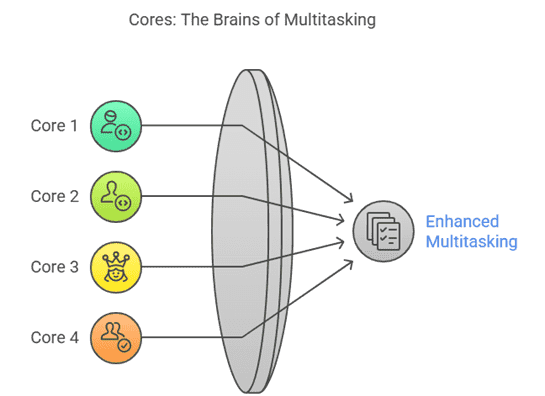
- Clock speed are measured in Gigahertz (GHz), The amount of GHz printed on the processor indicate that indicates how quickly the PROCESSOR can execute instructions. A higher clock speed means snappier and more responsive performance, particularly in tasks that rely on single-core performance, as well as contributing to smoother experience during gameplay in many games.
For a budget gaming gaming PC in 2025, There are many Processors offer an excellent balance of performance and affordability:
The AMD Ryzen 5 5600G is one of the best entry-level option. The “G” in its name signifies that is equipped with an integrated graphics processor, or IGP, to run high end graphics output on your PC without using a dedicated video card. This is a significant advantage for beginners who might initially do not want to purchase a dedicated graphics card, as the integrated graphics will allow your PC to function and even play most games which are using lesser graphics. The Ryzen 5 5600G offers six cores and having a capable clock speed, making it a solid foundation for a budget gaming.

Prices for this Processors have been seen around ₹12,509 – ₹ 22,000/-, and it’s realistic to expect similar or possibly lower prices in 2025.
The Intel Core i5-12400F– For Building Your Budget gaming PC in 2025
Intel Core I5 12400F 12 Gen Generation Desktop Pc Processor 6, PROCESSOR with 18 MB Cache and Up to 4.40 GHz Clock Speed, DDR5 and DDR4 Ram Support LGA 1700 Socket, Micro ATX

- This is another strong option, offering excellent gaming capabilities when paired with a dedicated GPU. The “F” at the end of its name shows that it does not have integrated graphics, so you need to install a dedicated GPU for this PROCESSOR to output a display.
- However, gamers know they will be purchasing a dedicated graphics card, the i5-12400F provides a strong combination of cores and clock speed at a viable price, frequently found around ₹9,699. Its strong performance makes it a popular choice for a budget gaming Computer.
Intel Core i5 12400F is a 12th-generation Alder Lake processor with 18MB of Cache Memory. The 12400F has a Total of 6 Cores (6 Performance Cores) and 12 Threads. This is the best processor so far released.
The AMD Ryzen 5 7600X,AMD 7000 Series Ryzen 5 7600X Desktop Processor 6 cores 12 Threads 38 MB Cache 4.7 GHz Up to 5.3 GHz AM5 Socket (100-100000593WOF)

- This processor is something extraordinary in terms of performance😍 and futureproofing. AMD’s new AM5 platform, offers extraordinary gaming performance and supports😮 the latest technologies like DDR5 RAM. While the processor itself costs somewhere around ₹20,000, it’s important to note that building with a Ryzen 7000 series processor requires an AM5 motherboard (which is also costly) and DDR5 RAM, which will increase the overall cost of the system. However, this configuration offers superior performance, and a longer upgrade path compared to any older configuration.
- The choice between these processors often depends on the PC builder’s overall budget, whether integrated graphics (Graphic card) is initially required or it can be managed somehow, and then later can be upgraded as the budget permits. Both AMD and Intel provide viable options in the budget PROCESSOR market. It is crucial to remember that the chosen processor will dictate the type of motherboard required due to socket compatibility.
B. The Visual Powerhouse: Graphics Processing Unit (GPU)- Budget gaming PC in 2025
- The Graphics Processing Unit, or GPU, or graphics card is the bonus component especially responsible for picture quality and a smoother experience, making it an unconditionally critical component for gaming. A powerful graphics card is essential for smooth and entertaining gameplay, especially at higher screen resolutions and with more advanced graphical settings. As we all know, nowadays games are really very much advance and requires high end graphical settings.
- When picking a Graphic card, one of the most important requirements is VRAM, or Video RAM. VRAM is dedicated memory on the graphics card that stores qualities, frame buffers, and other graphical data. Moreover, in simple language, VRAM mostly allows the graphics card to handle more complex scenes, higher resolutions (like 1440p or 4K), and games with high consistency settings without undergoing any performance degradation.
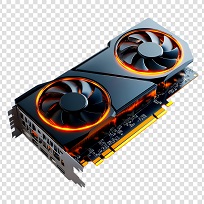
For a budget-friendly gaming PC in 2025, the following Graphic Card stand out as strong contenders:
- The NVIDIA GeForce RTX 3050 (8GB) is a compact entry-level graphics card capable of providing a good 1080p gaming experience at medium to high settings in many modern games. 8GB of VRAM, is sufficient memory for 1080p games. Higher configuration games may show some distortion The prices of RTX 3050 graphic cards can be bought in the range of ₹20,000 to ₹28,000. However, it’s worth noting that prices can fluctuate, and our sources suggest that prices may rise in 2025.
- The AMD Radeon RX 6600 is considered to be strong competitor to the RTX 3050, It offers slightly better raw performance in some games at a similar price point. It also has 8GB of VRAM, the RX 6600 is also well-suited for 1080p gaming and can even handle some games at 1440p with advanced settings. Our sources confirms that Prices for the RX 6600 is in the range of ₹18,000 to ₹23,000 , making it a very attractive option for gamers on a budget.
If you want a slightly in budget Graphic card then,
- The Intel Arc A750 presents an interesting alternative in GPU market. It offers good performance in this price and in few instances can compete with the RTX 3050 and RX 6600. The Arc A750 also comes with 8GB of VRAM. While it can be an interesting option with prices potentially lower around ₹18,000 to ₹19,000 , it’s important to know for beginners that driver support for Intel’s Arc series is still maturing, and game compatibility and performance can vary.
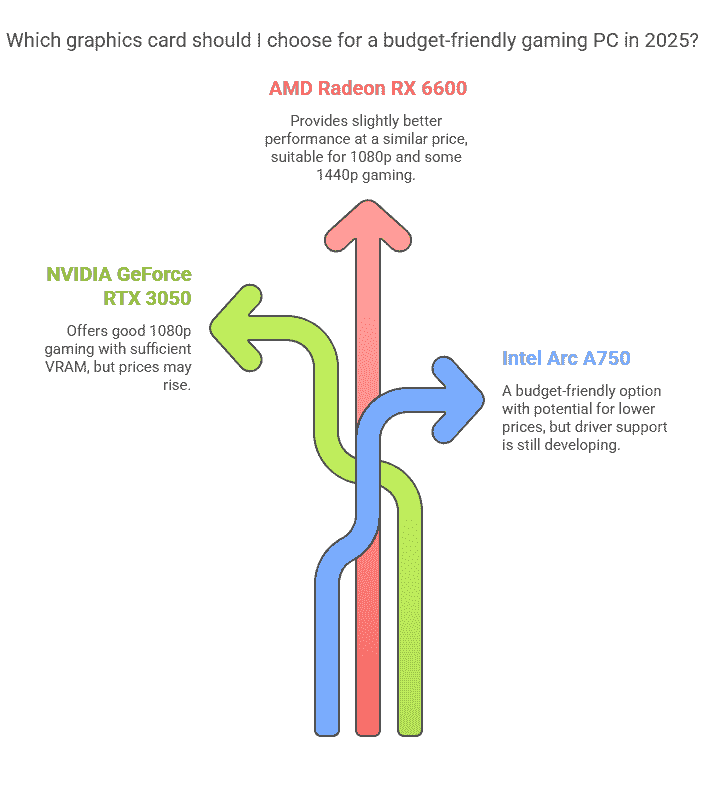
The choice of Graphic Card is often the most critical factor in determining a gaming PC’s performance. In the budget segment, NVIDIA, AMD, and Intel are all offering many competitive options. The “best Graphic Card ” for you will depend on the specific games you intend to play, your budget, and how much you are prepared to potentially troubleshoot driver-related issues, particularly with newer entrants like Intel Arc.
C. Short-Term Memory: Random Access Memory (RAM)- Budget gaming PC in 2025
Random Access Memory, or RAM, is responsible for your computer’s short-term memory. It provides temporary storage for data that the PROCESSOR needs to access quickly, which acts like Graphic card’s immediate workspace. The amount and speed of RAM can significantly impact your system’s responsiveness, especially while multitasking and gaming together.
For a budget gaming PC in 2025, the general recommendation is:
- 8GB: This is considered the absolute minimum for most games, but it is highly recommended to aim for at least 16gb if you are going to use your system for gaming for a smoother experience. In many modern games, 8GB can lead to performance bottlenecks and thus lead to irritation while playing games.
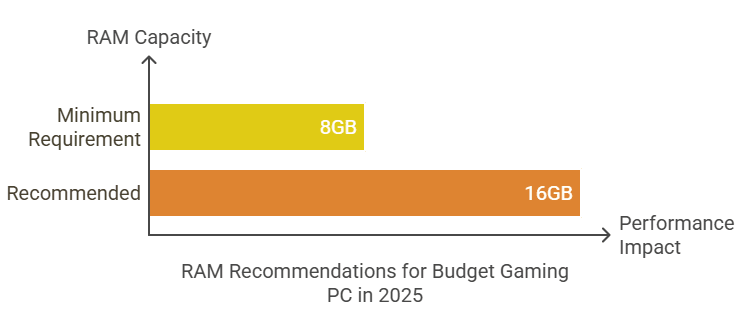
- 16GB: This is considered the “sweet spot” for most budget gaming builds in 2025. 16GB of RAM allows you to play majority of games without significant issues and provides sufficient room for other applications running in the background, such as browsing or chatting. It is generally advisable to purchase two RAMs (two sticks of RAM) for better performance.(8gb +8gb)
Here are some budget-friendly recommendations for 16GB (2x8GB) DDR4 3200MHz RAM kits:
- Corsair Vengeance LPX 16GB (2x8GB) DDR4 3200MHz: This is a popular, reliable and budget friendly choice, often found at affordable prices, around ₹2,600 to ₹3,000.
- Crucial Ballistix 16GB (2x8GB) DDR4 3200MHz: Crucial is another famous and reputable brand, and their Ballistix series offers good performance at this price, typically in the range of ₹3,500 to ₹6,000.
- G.Skill Ripjaws V Series 16GB (2x8GB) DDR4 3200MHz: G.Skill is famous for its gaming-oriented RAM, and the Ripjaws V series provides an absolute balance of performance and cost, usually priced between ₹2,400 and ₹3,900.
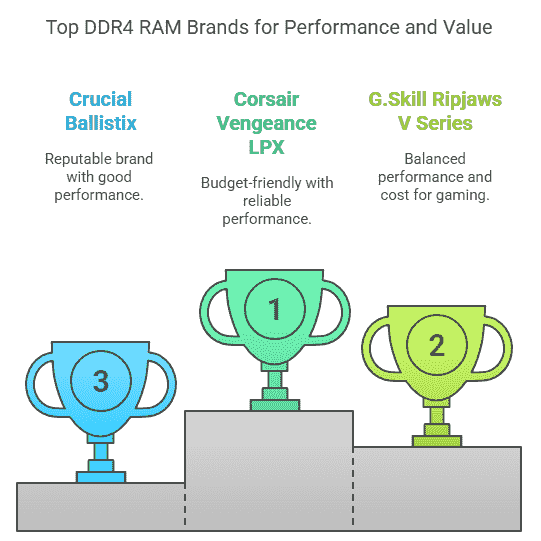
Note: If you have chosen a newer platform like AMD’s Ryzen 7000 series, which utilizes the AM5 socket, you will have to look for DDR5 RAM. DDR5 offers higher speeds and potentially better performance, but it is generally more expensive than DDR4.Anyway If go for DDR5, consider looking for speeds around 5200MHz or higher for a clear benefit.
However, for a strict budget in 2025, DDR4 remains a very obvious and cost-effective option for Budget gaming PC in 2025 using older platforms like AM4 or Intel’s LGA1700 socket with compatible motherboards. Lower RAM can lead to significant performance issues, including stammering and slow loading times, which can worsen your overall gaming experience.
It’s important to use two RAM sticks in the correct slots on your motherboard, as described in the manual, and enable dual-channel operation. This setup can boost memory bandwidth and improve overall system performance.
D. Long-Term Storage: Solid State Drive (SSD) and Hard Disk Drive (HDD)
If you’re planning to set up a Budget gaming PC in 2025, it is smart to choose a smaller SSD for your operating system and your most played games. This setup gives you faster loading times. An SSD with a capacity of 250GB to 500GB is usually enough for this need. You can then add a larger HDD, like 1TB or 2TB, to store more games, less-used files, and other data that don’t need fast access.
For budget gaming PC in 2025 here are some budget-friendly SSD and HDD recommendations:
SSD (250GB-500GB): Building Your Budget gaming PC in 2025
- Crucial MX500 500GB SATA SSD: This is a budget friendly reliable choice if you’re looking for a SATA SSD. It usually provides good performance with a reasonable price, making it a popular option. You can buy this between ₹4,100 and ₹5,600.😁
- Samsung 970 EVO Plus 500GB NVMe SSD: If you want a smoother experience and speed, then NVMeSSD is a great option. It reads and writes data much faster than SATA SSDs, which means your computer will load faster. But then be ready to pay around ₹4,800 and ₹6,800 for this model.😬
- Western Digital WD Black SN770 500GB NVMe SSD❤: I use this which is Known for its excellent performance, especially in gaming. The WD Black SN770 is a top choice for NVMe SSDs. It offers smoother performance at an affordable price of about ₹4,000 to ₹4,300.😀
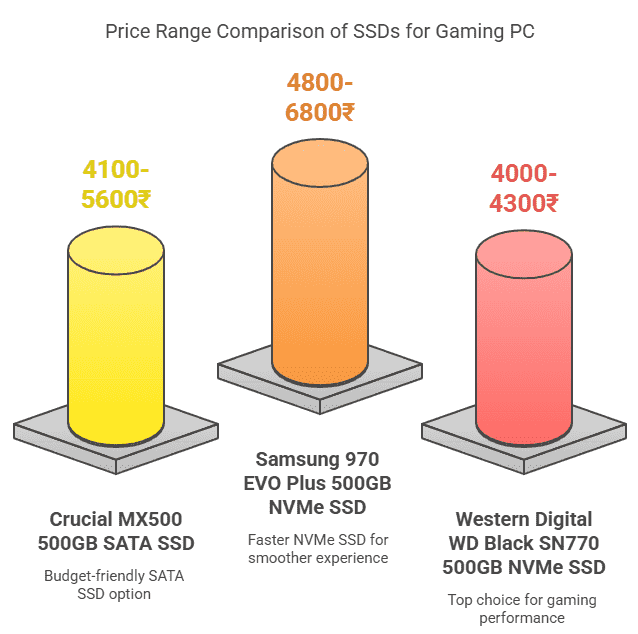
HDD (1TB or 2TB): For Budget gaming PC in 2025
- Seagate Barracuda 2TB 7200RPM: A smart choice for huge storage, offering a large capacity at a reasonable price, you can buy this for around ₹5,900 and ₹9,100 anywhere in the market.
- Western Digital WD Blue 2TB 7200RPM: Similar to the Seagate Barracuda, the WD Blue provides large amount of storage space and a good speed for an HDD, usually this is comparatively affordable priced around ₹5,300 to ₹6,500.😀
Our sources have observed that in recent years, NVMe SSDs are becoming more affordable, making them a practical option as the primary storage even for budget-conscious configurations. Although HDDs still offer the best price-per-gigabyte, But the speed which SSDs provide for the operating system and modern-day games is highly noticeable and SSD’s contribute significantly to the overall user experience.
E. The Foundation: Motherboard- Building Your Budget gaming PC in 2025
The motherboard is the most important central circuit board of your PC. It acts as the backbone; it connects all components together which further allows them to communicate with each other. Think of it as the central governing hub where all the different parts of your PC plug in and interact.
While looking for a motherboard for a budget gaming PC, several key factors come into play:
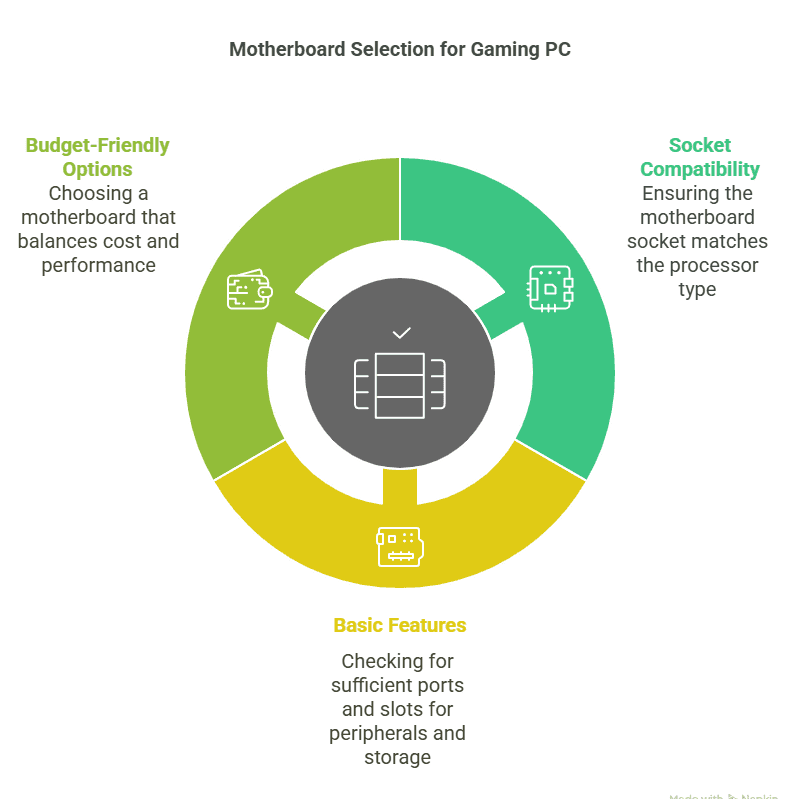
- Socket compatibility with PROCESSOR: As all components are important but This is the most crucial factor. The motherboard socket (e.g., AM4, LGA1700, AM5) should and must match the socket type of your selected processor. An incompatible or mismatched motherboard will not be able to physically connect to your processor so select wisely.
- Basic features: Ensure before paying the motherboard has enough ports for your needs in present as well as future, including USB ports for peripherals, SATA ports for storage devices, and enough RAM slots for your desired amount of memory. A PCIe x16 slot is essential for installing your dedicated graphics card. Different company motherboards have diverse number of slots for RAM and Graphic cards.
Our sources have selected few budget-friendly motherboard based on the processor platform you choose:
For AMD Ryzen 5000 Series (AM4 Socket): Building Your Budget gaming PC in 2025
- MSI B450 Tomahawk Max II: This is a well-known ATX motherboard that offers a large number of features and excellent compatibility with Ryzen 5000 series Processors. Prices usually differ from ₹9,400 to ₹11,500. It includes features like a Flash BIOS Button, which can be helpful for ensuring compatibility with newer Ryzen processors in future if you want to upgrade.
- ASUS PRIME B450M-A II: This a budget friendly option if you are willing to choose and is more compact Micro-ATX motherboard but offers good compatibility with Ryzen 5000 series Processors at a comparatively lower price, around ₹6,700 to ₹10,900. It also often features BIOS Flashback for easy BIOS updates.
For Intel 12th/13th Gen (LGA1700 Socket): Building Your Budget gaming PC in 2025
- MSI PRO B660M-A WIFI: This is a premium choice for high end gamers. This Micro-ATX motherboard is awesome and provides a solid foundation for Intel’s 12th and 13th generation processors. It also includes in-built Wi-Fi, which can be useful and convenient. Prices are in the range of ₹14,500 to ₹17,200. 😮
- Gigabyte B660M DS3H DDR4: Here is another Micro-ATX option for LGA1700 Processors, and it can be bought at a slightly more affordable price, around ₹11,200 to ₹12,600. It supports DDR4 RAM, which will help you to keep the overall cost down.
For AMD Ryzen 7000 Series (AM5 Socket):
- MSI PRO B650M-A WIFI: This Micro-ATX motherboard is an is starting point to AMD’s latest AM5 platform, supporting Ryzen 7000 series Processors and DDR5 RAM. As this is the latest version currently available. Prices are on the higher side generally around ₹15,100 to ₹16,800.
- ASUS PRIME B650M-A WIFI: Similar to the MSI option, Asus also provides this Micro-ATX motherboard which supports AM5 Processors and DDR5 RAM, it offers a large number of features. Prices are typically in the range of ₹18,100 to ₹20,500. Prices are high, but the numbers of features it provides makes it a viable option if you are ready to move into a premium segment.
The most important thing, when selecting a motherboard is to ensure that its socket type is compatible with your chosen processor. The motherboard chipset (e.g., B450, B660, B650) which you will select will determine the features and connectivity options available.

F. Powering It All for Building Your Budget gaming PC in 2025: Power Supply Unit (PSU)/SMPS.
The Power Supply Unit, or SMPS, is the most important component is a root of your system plays a crucial role in your PC by providing stable and reliable power to all the components. A best quality PSU is essential for the long lasting and stability of your system.
The key specification to keep in mind when choosing a PSU is its wattage, which means the amount of power the PSU can deliver, measured in Watts. You need to select a PSU with required wattage so that it can provide enough power range to all the components in your PC.
For a typical budget gaming PC with a mid-range GPU, the PSU with a wattage in the range of 500W to 650W from a well-known brand should be sufficient. It is generally expected to have some extra wattage range to account for power spikes and preferably future upgrades.
Here are some budget-friendly and reliable SMPS/PSU recommendations from a well-known Brands:
- Corsair CX Series (550W or 650W): Corsair is a well-known brand, and their CX series PSU offer a decent balance of reliability and affordability. The 550W version can often be found around ₹3,400 to ₹4,400 and its bare minimum for a budget gaming PC.
- Seasonic FOCUS GX Series (550W or 650W): Seasonic provides a premium version and highly regarded for the quality and efficiency of their power supplies, it has 80 Plus Gold certification. However, according to our sources and available data, these might be priced much higher in India compared to other budget options.
- EVGA SuperNOVA GA Series (550W or 650W): EVGA is another reputable premium brand in the PSU market, offering models with 80 Plus Gold certification and fully modular designs. Same as Seasonic, prices in India are much higher. But you can very well choose this if your budget allows and trust me their performance is great.
- Be quiet! System Power 9 (500W or 600W): Usually gaming pc are little noisy but Be quiet! is known for their quiet and reliable components. The System Power 9 series offers 80 Plus Bronze certification and is a great option for budget gaming PC. According to sources estimated prices in India is around ₹3,500 to ₹4,500.
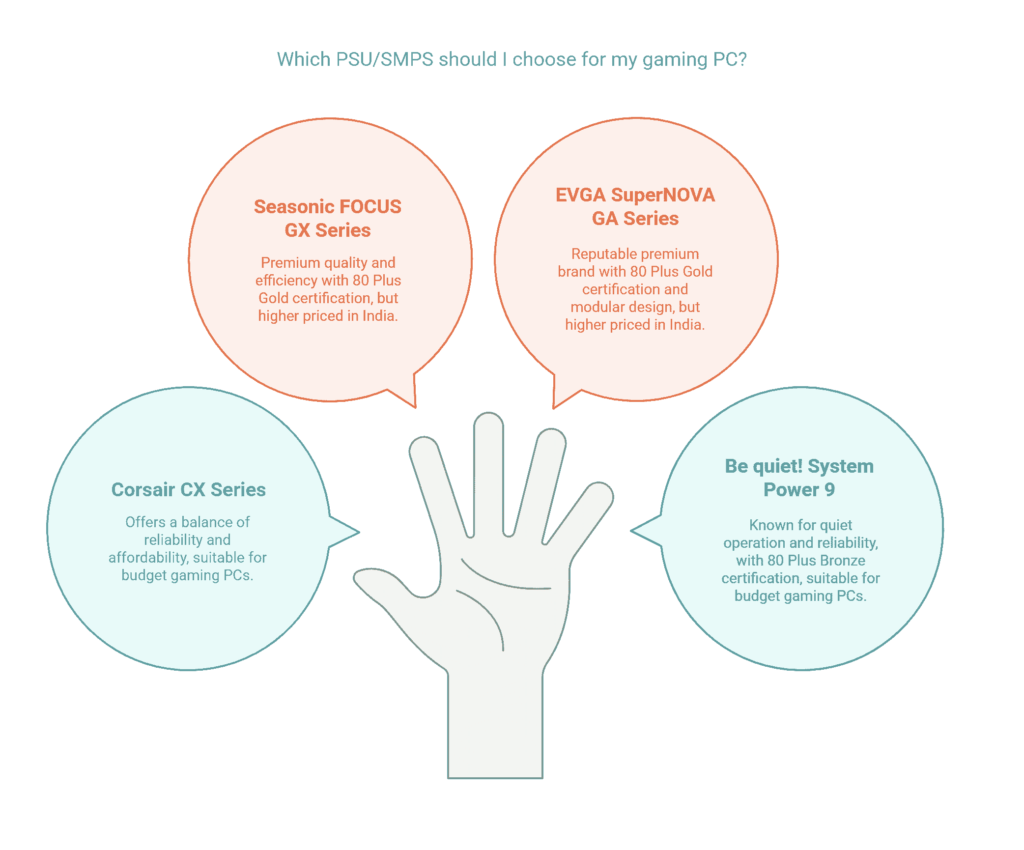
If you take my advice then, while choosing a PSU / SMPS, it is crucial to stick to well-known and reputable brands with good reviews for reliability and safety. Avoiding generic or unbranded PSUs will not be great for your gaming pc, as they may not provide stable power and could potentially damage your important components such as motherboard, RAM, SSDs etc.
G. The Home: PC Case-For your Budget Gaming PC.
Although most people think that PC case is not so important but PC case serves as the enclosure for all your computer components. As Gaming PC usually contain high end components and dispense a large amount of heat while you play a high-end game, the case plays a vital role in providing good airflow to keep your components cool and prevents overheating. Additionally, a well-designed case can help you in building process by offering ample space for installing components and managing cables.
Here are some excellent as well as budget-friendly case recommendations:
- Corsair Carbide Series SPEC-01 or SPEC-03: This is a great option in popular mid-tower cases that offer a good balance of features, high airflow, and ease of building at a reasonable price, Prices range around ₹3,400 to ₹3,900.👌
- Cooler Master MasterBox Q300L (Micro-ATX) or MB511: The Q300L is little compact Micro-ATX case but offers flexibility in terms of component placement and with a competitive price, around ₹3,400 to ₹3,900. The MB511 is a mid-tower ATX case known for its airflow.
- NZXT H510: If you are looking for a pleasing and relatively easy to build in, the NZXT H510’s can be considered but airflow has been noted as potentially restrictive. However, it remains a popular choice for its clean design and compact form factor, with prices around ₹5,200 to ₹9,400. You need to consider the airflow limitations if using high-power components.
- Fractal Design Meshify C: Now comes this mid-tower ATX case, which is highly regarded for its excellent airflow due to its mesh front panel. But is slightly more expensive, around ₹6,400 to ₹6,900 , the superior cooling it provides can be worth the investment.
Note: When choosing a case, consider the size of your motherboard. ATX cases are comparatively bigger standard size and offer room for components and expansion, while Micro-ATX cases are relatively smaller and require a Micro-ATX motherboard. You have to choose your PC based on your available space and desired aesthetics.
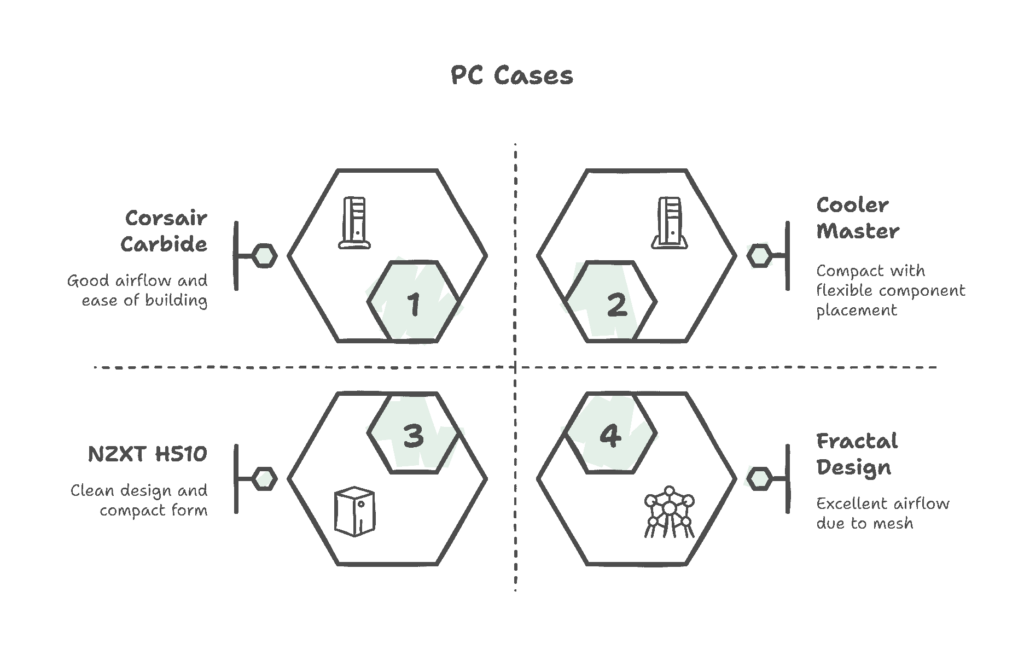
III. Budget estimation and Choosing Parts Wisely for your gaming PC.
A. Setting a Genuine Budget:
Before getting into specific components, it’s wiser to establish a genuine budget for your gaming PC. The cost of each component can vary from place to place, but here are some rough guesstimates for a budget gaming PC in 2025:
- PROCESSORS: $100 – $250 | Rs 8000 – Rs2200.
- GPU: $150 – $350 | Rs 12000 – Rs 28000.
- RAM (16GB): $50 – $80 | Rs 4000 – Rs 6000.
- Motherboard: $80 – $150 | Rs6000 – Rs 12000.
- SSD (500GB): $40 – $70 | Rs 2500 – Rs 5000.
- HDD (2TB): $50 – $70 | Rs 4000 – Rs 5000.
- PSU: $50 – $100 | Rs 4000 – Rs 8000.
- PC Case: $50 – $100 | Rs 4000 – Rs 8000.
These are just rough estimates, and actual prices can differ based on sales, brands, specific models, and mainly retailer. To get on top of your budget, consider the following tips to get the most of your money without sacrificing too much performance:
Buying used parts carefully: Consider purchasing secondhand GPUs or RAM from reputable sellers. Used components, especially graphic cards/GPUs, can sometimes offer significantly better performance for the price. However, keep in mind that the Graphic card may have been used heavily and most importantly no guarantee for the product. Try to purchase from sellers with good reputations and ask for a replacement within a timeframe if it is not working properly. Or if possible, test the component before finalizing the purchase. Local computer hardware dealers might also be a source for used components. This will reduce your budget considerably.
Waiting for sales: Plan for a Gaming PC before and keep a close eye on prices and wait for discounts and deals, especially during major shopping events like Flipkart big billion days, Amazon Sales, Black Friday, Cyber Monday, or local festive seasons. Prices of PC components usually fluctuate, and patience usually lead to significant savings. 😊
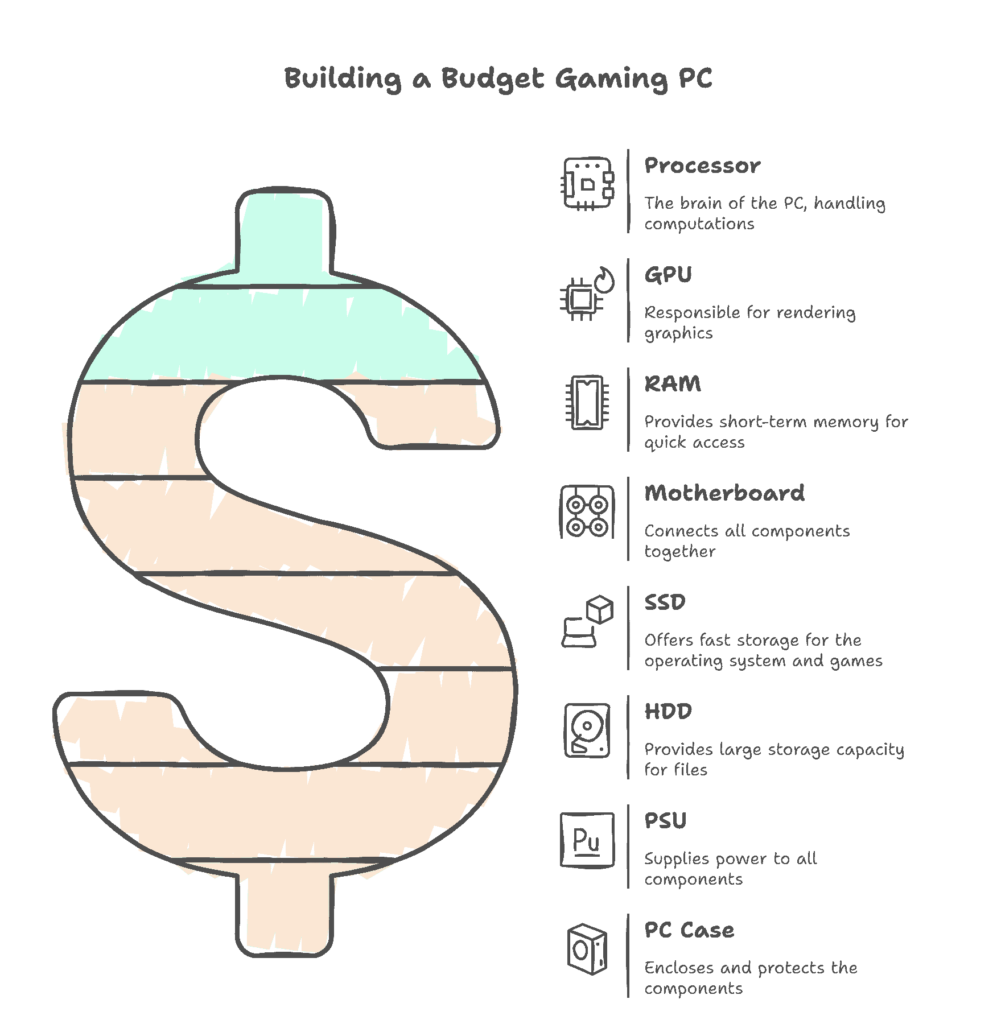
Considering little older but still capable components: Last-generation Processors and GPUs usually offer excellent value for their performance in 2025. Research benchmarks and look for reviews to see if older models still meet your gaming needs.
B. Compatibility is Key: For your budget gaming PC
Ensuring that all your selected components are compatible with each other is very important in building a successful gaming PC. Among all the compatibility issues the most important is the combination of processor and motherboard. The PROCESSOR socket on the motherboard (e.g., AM4, LGA1700, AM5) must be compatible with the physical socket of your chosen processor. If you are doing it yourself using tools like PC Part Picker (www.pcpartpicker.com) or checking the specifications on manufacturer websites can be of great help to verify this compatibility.
Another important aspect is RAM compatibility. Ensure that your motherboard supports the type of RAM you are going to use (DDR4 or the newer DDR5) and the speed of the RAM, which really matters. While DDR5 offers better performance, smoother experience but it is currently more expensive, and for a budget gaming PC in 2025, DDR4 might still be the more cost-effective option for many platforms. Always look after the motherboard’s specifications for supported RAM types and speeds.
C. Researching and Reading Reviews:
Once you have decided your components, before making any purchasing decisions, Professionals suggests to go for a review check, thorough research of your selected components is necessary. Visits different websites to check customers review on your components that will give you clear idea of how your components usually performs. Few websites compare various Processors, GPUs, and other components, helping you identify the best options within your budget.
In addition to performance benchmarks, go through user reviews on online retailer websites (e.g., Amazon, Flipkart) which will provide valuable insights into the reliability, ease of use, and most importantly issues with specific parts. Go through both positive and negative reviews to get a well-rounded perspective.
D. Creating Your Parts List:
After completing your first step i.e. understanding of the different components and have done your research, the next step is to prepare a list of your parts you plan to purchase before you start buying. This will help you to check your expenses and stay organized as well as ensure you haven’t forgotten anything.
IV. The Step-by-Step Building Process- building your budget gaming PC in 2025.
A. Preparation and Safety First:for your budget Gaming PC.
Once you have arranged all your components for your first budget gaming PC and start the physical process of attaching all components together, careful preparation is essential. First and foremost, grounding yourself is an important step to prevent electrostatic discharge (ESD), Computer components are delicate which can be damaged due to electrostatic discharge so grounding is a necessary step. Before handling any parts, touch a grounded metal object, such as the unpainted metal part of your computer case and yes ofcourse when it is unplugged.
For extra safety, anti-static wrist strap is used to connect your wrist to a grounded part of the case. Now it’s time to set up your workspace and organize your components. A well-lit room should be used to go ahead with the process. Keeping your components in their original packaging until you need them will allow you to find them easily and check for specifications.
Finally, make sure you have all the necessary tools ready. The most important and essential tool is a screwdriver, preferably with a magnetic tip, as this will help you while handling small screws inside the case. You will also need zip ties or Velcro straps for alike cables together to keep them inside of your PC case and ensure enough tidy space for improved airflow. An optional but helpful tool is a small container, a small magnet or a rubber mat to keep track of the various screws you will be removing and installing.
B. Installing the PROCESSOR on the Motherboard: for your budget Gaming PC.
- Find the processor socket on the motherboard. It will have a lever or latch mechanism. Usually a latch mechanism.
- Carefully with soft hands open the processor socket lever or latch.
- Carefully place the arrow or triangle on the corner of the processor with the shown mark on the processor socket. This ensures the processor is placed correctly.
- Gently place the processor into the socket. It should sit in level without putting any force. If it is not sitting easily, double-check the alignment. You may be placing in a wrong way, double check and place the processor correctly.
- Once the processor is placed correctly, close the processor socket lever or latch. This will lock the processor in place.
- Most processor has thermal paste pre-applied if your processor cooler does not have thermal paste pre-applied, you will have to apply a small amount (about the size of a grain of rice or a pea) to the top center of the processor. This will help in transferring heat from the processor to the cooler.
- Now it’s time to place the processor cooler on top of the processor, make sure the cooler aligns with the mounting holes with the standoffs or brackets on the motherboard.
- Place the screws on cooler wherever needed, tightening them evenly in a crisscross pattern to ensure even pressure. There will be a guide available in the processors box Follow them correctly to ensure for the correct mounting procedure.
- This is the most important and one of the most difficult job in DIY of building your budget gaming PC, If you have done it correctly and perfectly which is important than the other process is more or less easy and you have reached the halfway.
C. Installing RAM Modules: for your budget Gaming PC.
- Go through your motherboard manual to pin point your correct RAM slots to use for dual-channel configuration. These slots are often the same colour or indicated in the manual as well as on the board you just have to look for them on the motherboard.
- Open the clips gently with soft hands at both ends of the designated RAM slots.
- Place the RAM stick with the notch in the RAM slot. This ensures the RAM is inserted in the correct orientation and fix the notch.
- Press down firmly and evenly with both ends of the RAM stick until it clicks into place, And keep in mind is just a RAM on motherboard so the clips on the ends of the slot snap shut, securing the RAM.
D. Mounting the Motherboard in the Case: for your budget Gaming PC.
- Usually, PC cases have standoffs pre-installed. If your chosen PC case does not have it, you will need to screw them into the designated holes in the case. These standoffs are used to lift the motherboard and prevent short circuits by ensuring it doesn’t touch the metal case.
- Carefully fix the motherboard with the standoffs and the screw holes in the case.
- Secure the motherboard to the standoffs with screws. Make sure you do not overtighten the screws, as this may damage the motherboard.
E. Installing the Graphics Card: for your budget Gaming PC.
Now its graphic card’s turn the primary PCIe x16 slot on your motherboard. Usually the longest PCIe slot, and this will be of a completely different colour than the other slots.
- Open the fixing clip at the end of the PCIe slot.
- Place the graphics card in the slot provided and press down firmly and evenly until it clicks into place and the retaining clip closes. You will hear a click sound when it’s properly seated.
- Fix the graphics card to the case with screws, usually it is there at the back of the case, to prevent it from moving.
F. Installing Storage Devices (SSD/HDD): for your budget Gaming PC.
- SSD/HDD: Now just the connections in dedicated slots needed, So connect your SATA data cable from the data port on the SSD or HDD to a SATA port on the motherboard. Done! Connect a SATA power cable from the power supply unit to the power connector on the SSD or HDD these all ports are defined and the cable will not fit anywhere else so need not worry just look for the correct port.
- NVMe SSD: Look for the designated M.2 slot(s) on your motherboard. Place the NVMe SSD into the slot, aligning the SSD with the key in the slot. Now fix the SSD with a small screw, typically located near the M.2 slot.I told you just have to look for screw place or designated latch and the components fix easily.
Place the drives (both SSDs and HDDs) into the appropriate drive bays in your PC case and fix them with screws using your screw driver just remember not to over tightened the screws. Go through the manuals if necessary. The manual will usually indicate the location and method for securing drives.
G. Installing the Power Supply Unit (PSU): for your budget Gaming PC.
Fix the power supply unit in its designated compartment in the PC case, that will be at the bottom or top rear of the case.
Tighten the screws and secure the PSU..
Now connect all the power cables from the PSU to your components:
- Motherboard: 24-pin ATX power connector is the main connecter for motherboard and the 8-pin (or 4+4 pin) EPS PROCESSOR power connector. Connect both the power cables carefully to avoid any pin damage.
- GPU: Graphic cards may require additional power, so connect the appropriate PCIe power connectors (6-pin or 8-pin) from the PSU to the graphics card. The designated cable will fit in its own slot so double check before applying any force to fit the cables.
- Storage: Make sure SATA power cables are connected to your SSD and/or HDD.
Note: Double check all your components are connected properly.
H. Cable Management (Basic but Important): for your budget Gaming PC.
Make sure you try to route the cables from behind the motherboard tray or through any available cutouts in the case. This is to ensure you keep the main compartment of the case clear for improving airflow.
Clear the fan area to prevent them from getting caught and obstruct cooling.
Using zip ties or Velcro straps to bundle and secure cables together will help to clear the PC case area. This makes the inside of your case cleaner, thus ensures improved airflow, and makes it easier to work inside the PC in the future.
I. Closing Up the Case: for your budget Gaming PC.
Now, when everything is put in place and all components are installed and cables are bundled together and put aside and you are satisfied. Carefully close the side panels of your PC case. Apply the appropriate screws or latches. Done! 😀
V. First Boot-Up and Initial Software Setup for your budget Gaming PC.
A. Connecting Peripherals: For your budget Gaming PC.
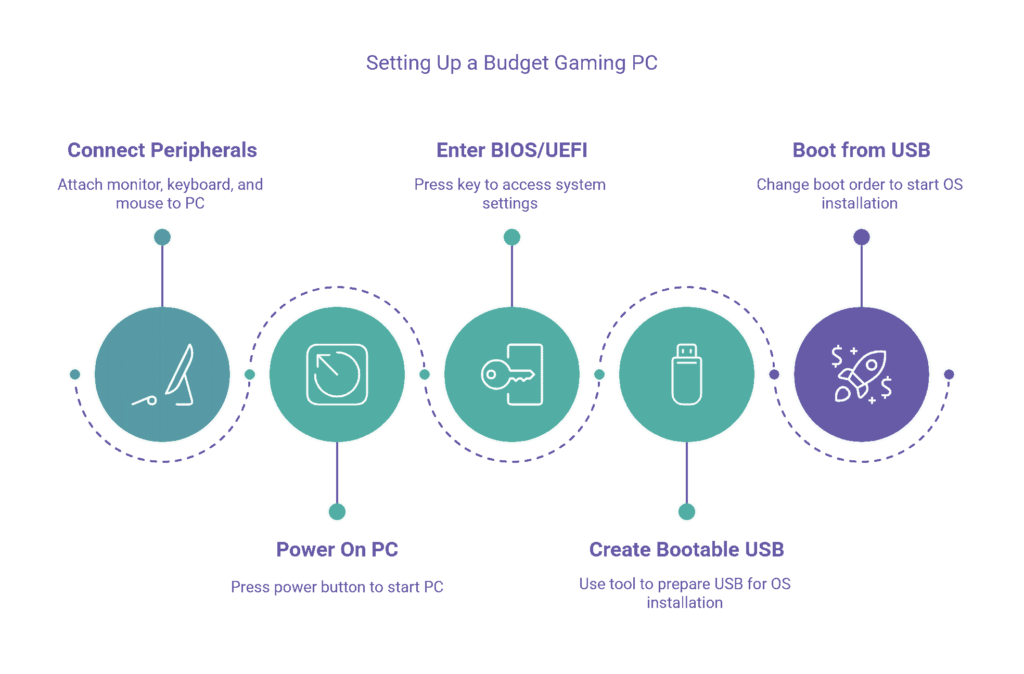
Now the most part is done you just have to connect your monitor to the output port on your PC case(PSU) (either HDMI or DisplayPort). Make sure the cable is securely plugged in. Connect your keyboard and mouse to USB ports on the motherboard’s rear panel.
B. Powering On for the First Time: For your budget Gaming PC.
Press the power button on your PC case. Amazing lights are ON! Fans start spinning within the case WOW! Tell me how you feeling…Excited😍. You must be… During first startup, you will see a prompt on your monitor indicating which key to press to enter the BIOS/UEFI settings. Usually Delete, F2, or F12. The BIOS/UEFI is the firmware interface that allows you to configure your system settings.
C. Installing the Operating System (Windows Example): For your budget Gaming PC.
you must be knowing all this still in short will tell you …
Create a bootable USB drive: Use Media Creation Tool and create a bootable USB drive containing the Windows installation files. This can be downloaded from Microsoft’s website. You just have to follow the instructions provided by the tool to create the bootable USB drive.
Booting from the USB drive: Enter the BIOS/UEFI settings as described above. Find the boot order settings (the exact location will vary depending on your motherboard manufacturer). Change the boot order select booting from your USB drive. Save the changes and exit. Your PC should restart and automatically boot from the USB drive; your system will start initiating the Windows installation process. You just have to follow the on-screen instruction to complete the Windows installation. It’s not a rocket science just try once and you will do it yourself. If you face any problem just revert back, I will give you a complete guide on that.
D. Installing Drivers: for your budget Gaming PC.
Once installation of windows is complete preferably Windows 11, It installs all drivers automatically but still few drivers need to be installed for your graphic card to function properly. Drivers are software that lets your computer talk to its peripherals making sure everything works well and stays stable. To find the newest drivers, go to the hardware manufacturer’s website. For your motherboard, check the site of the company that made it, like ASUS, MSI, or Gigabyte. For your graphics card, download the latest drivers from the website of the company that made it. For example, if your GPU is from NVIDIA, visit nvidia.com. If it’s from AMD go to amd.com and if it’s from Intel head to intel.com.
VI. Congratulations and Next Steps! – for your budget Gaming PC.
Congratulations! 😂You have successfully built your budget gaming PC. Take a bow! appreciate yourself and your hard labour. Now it’s time to enjoy some gaming! 😁
I have jotted down few basic troubleshooting tips for issues you might face during your initial days of gaming:
- No power: First thing you should do is to check that the power cable is plugged into both the power supply unit (PSU) and the wall outlet. Make sure the power switch on the back of the PSU is turned on. If that does not help than go ahead to confirm that all internal power connectors are firmly connected.
- No display: Ensure that the monitor cable is connected to the PSU’s output port, such as HDMI or DisplayPort. Do not connect it to the motherboard’s ports. Double-check that the graphics card is properly seated in its PCIe slot. You may have to repeat the process more than once in your initial days.
- PC won’t boot: Remove the Ram and connect it again properly double check both your RAM are inserted into their slots. Also, check the installation of the processor and ensure that the processor cooler is properly installed. Consult your motherboard manual for specific troubleshooting tips and check the designated LEDs for further clues.
If you are not able to resolve the issue, don’t hesitate to seek help on online forums like Reddit’s / Quora or visit the tech support in their respective manufacturer’s websites. As you become more familiar with your new gaming PC, you might consider optimizing it further. Overclocking is another option that involves increasing your processor and/or GPU speeds beyond factory settings for better performance. Usually, factory settings are for normal users not for heavy gamers.
Do this carefully, and it’s best not to touch the settings in your initial days until you understand your system and cooling requirements. As your gaming needs change or your budget increases, you may plan for future upgrades. Gamers often upgrade their GPU first for better performance. Adding more RAM or moving to a larger or faster SSD are also common ways to improve your system. We will be more than happy if you share your experiences with your PC and ask any questions in the comments below. Your feedback and suggestions for future Articles are always welcome!☺
VII. Conclusion: For your budget Gaming PC.
Building your budget gaming PC can be a really fun and informative project. It saves you a lot of money since you have built your own budget gaming PC and designed your computer exactly the way you want. You’ll get a lot of information, a lot of useful tech knowledge during the process. There’s nothing quite like the feeling of playing your favourite games on a machine you build with your own hands. By using this Article, you already took your first steps into the world of PC building and made it through successfully. Now, you can dive into the exciting world of budget PC gaming with your own creation.
Great job on your accomplishment! 👍
“Disclaimer: Article contain many facts which has been taken from many useful websites kindly contact the writer before making any copyright claims.“


